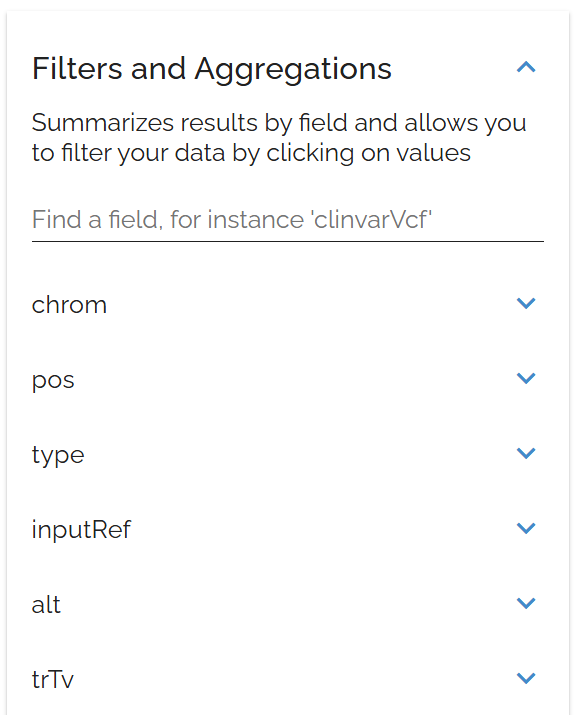Review Your Search Results
After running any search, Bystro provides a quick summary of your results and tools to help you understand and refine your query. Learn how to interpret result counts, performance metrics, and use the information to improve your analysis.
Search Results Summary
Every search in Bystro displays a simple summary showing exactly what was found and how quickly the search completed.

The search results summary line provides instant feedback on your query scope and performance
Understanding the Summary
Found 21,353 variants in 18 genes in 0.024sTotal number of variants matching your search criteria
Number of unique genes containing matching variants
Query execution time - Bystro's optimized performance
Pagination Information
Below the summary, you'll see pagination details that help you navigate through large result sets efficiently.
Page 1/2,136 (10 results per page)This shows you're viewing page 1 of 2,136 total pages, with 10 variants displayed per page. You can adjust the results per page or jump to specific pages as needed.
ClinVar Category Breakdown
Bystro automatically categorizes your variants by clinical significance, providing instant insights into the potential impact of your results. Click on any category to filter your results.

ClinVar category buttons provide quick filtering by clinical significance and risk level
Pathogenic Variants
High/Moderate Risk
Disease-causing variants with established clinical evidence. These require immediate attention in clinical settings.
Benign Variants
Low Risk
Variants with no known clinical significance. Often common population variants.
Protective Variants
Reduces Risk
Variants that may provide protection against certain diseases. Less common but important for research.
Drug Response
Affects Drug Response
Pharmacogenomic variants affecting drug metabolism, efficacy, or adverse reactions.
Other Clinical
Variable Impact
Variants of uncertain significance (VUS) or with conflicting interpretations.
Filters and Aggregation Panel
The Filters and Aggregation panel provides a comprehensive overview of your data by summarizing results across all annotation fields. Click on any field to see value distributions and apply filters.

The Filters and Aggregation panel lets you explore data distributions and apply precise filters
Key Features
- ✓Expandable summaries for every annotation field
- ✓Value distributions and frequency counts
- ✓One-click filtering by clicking values
- ✓Real-time updates as you refine searches
Useful Field Categories
- ▶Basic fields: chrom, pos, type, alt
- ▶Gene info: refSeq.name2, refSeq.siteType
- ▶Population data: gnomAD frequencies
- ▶Clinical data: clinvarVcf.CLNSIG
Using the Aggregation Panel Effectively
Start by expanding high-level fields like refSeq.siteTypeor clinvarVcf.CLNSIG to get an overview of your results:
- • See the distribution of variant types (exonic, intronic, etc.)
- • Check clinical significance breakdown
- • Identify most frequent genes or chromosomes
- • Spot data quality issues or unexpected patterns
Interpreting Your Results
Large Result Sets
- ⚠10,000+ variants may indicate a broad search
- ▶Use ClinVar buttons to focus on pathogenic variants
- ▶Check aggregation panel for dominant categories
- ▶Filter by exonic variants to focus on coding changes
Small Result Sets
- ✓Under 1,000 variants is often ideal for analysis
- ▶Review individual variants in detail
- ▶Use aggregation panel to understand data composition
- ▶Ready for export and further analysis
Query Performance
Bystro's optimized indexing typically returns results in under 0.1 seconds, even for complex queries across large datasets. If queries take longer:
- • Check if you're using very broad search terms
- • Consider breaking complex queries into smaller parts
- • Use more specific field searches rather than general text search
Next Steps After Review
Refine Your Search
Too many results? Add filters to narrow down:
- • Add frequency thresholds
- • Filter by variant impact
- • Specify genomic regions
Sort and Prioritize
Organize results by relevance:
- • Sort by CADD scores
- • Order by frequency
- • Group by gene or function
Save Your Results
Preserve your findings:
- • Save search for later use
- • Export to analysis tools
- • Share with collaborators
Pro Tip
The combination of variant count and gene count can tell you a lot about your search scope. Many variants in few genes suggests a focused search, while many variants across many genes indicates a broader exploration that might benefit from additional filtering.